The Knox “Ricochet” Back Protector
Fits under most motorcycle jackets.
Covers a large portion of the back.
Lining is stiff and has little cushioning, but apparently it is designed to protect the rider.
In a land where way too many motorcycle riders apparently believe that proper riding gear means shorts and a T-shirt, a back protector must seem as strange as clip-ons on a Fat Boy.
When I pull up to the gas pump in the middle of the summer in my head-to-toe riding gear, I laugh at those who laugh at me.
They think I look the fool and the feeling is mutual. I am sure I’ll be the one who’s laughing last.
I refuse to ride or drive with or near motorcycle riders who are without protective gear.
And I’ve been known to pull over for a time-out rather than have to bear witness to a shorts-and-T-shirt wearing motorcyclist.
You may think me extreme, but that’s how strongly I feel about it.
The older I get, the more safety conscious I become.
It has recently been discovered that young people, especially young males, do not develop a “danger factor” awareness in their brain until they reach their mid-twenties.
In other words, there’s a reason why youngsters do crazy things. They don’t fear death, or at least they don’t think that it can happen to them.
The older one gets, the more one realizes that life is, in fact, very fragile.
The natural corollary to this is to respect danger and take as many precautions as possible, or practicable.
Since my brain’s danger factor turned on way too many years ago, I have now become motivated to research any and all types of protective gear that could add to my longevity.
Where to Buy Knox Ricochet Back Protector
Also Shop for: Motorcycle Jackets, Motorcycle Gloves, Motorcycle Boots, Motorcycle Pants
Background
Back protectors have been used by motorcycle racers for some time.
They fit under a set of full leathers or other clothing and their job is to protect the rider’s backbone, back and ribs and to distribute the forces generated in a crash over a wider surface area.
Some motorcycle jackets are provided with built-in back protectors with varying levels of quality.
Some jackets have a flimsy piece of foam padding stuffed in the back, designed mostly for the manufacturer to claim that their jacket includes a back protector.
Others may include more robust forms of removable or non-removable padding, back protection or “armor”.
The ability of most original equipment back protectors to actually do anything to help the rider is questionable.
Motorcycle racers know this, and they use all the protection they can stuff into their leathers, including a “turtleback” type back protector like the Knox Ricochet Back Protector shown here.
There are many types and styles of back protectors, such as “mini” protectors that act as a kidney belt and protect a few vertebrae; thin, light weight models designed for bicycle riders and the full coverage back protectors used by motorcycle racers.
I had not previously owned or tried a full back protector, nor had I even seen one until the Knox Ricochet arrived in the mail. So I had no notion of how they fit, if they were comfortable to wear or how they would affect my riding.
Surely there are some webBikeWorld visitors with much more experience in choosing and wearing back protectors, and we’re hoping they will write us with their comments.
Knox Ricochet
I chose the Knox Ricochet for a couple of reasons. I was familiar with the Knox brand, because many motorcycle jackets and pants have Knox armor installed right from the factory.
Knox also claims to be the “first company in the world to gain CE approval for their impact protectors”.
All Knox armor is CE-approved to the European Impact protector standard EN 1621-1:1997 and EN 1621-2:2003, so I figured they must know their stuff.
Knox makes several different types of back protectors. The Knox Stowaway back protector (review) is claimed to be the lightest protector they offer at 600 grams (ours weighed 544 g).
The Ricochet shown here weighs 2.2 lbs., or 1 kg. The Stowaway is a new shape for Knox that was designed and developed for Rizla Suzuki Team rider Yukio Kagayama.
It’s designed to roll up for storage (why, I don’t know), and it’s supposed to come with its own storage bag. We originally ordered a Stowaway, but were shipped a Ricochet instead, unbeknownst to us, and the Ricochet does not include a storage bag.
Because I’m a back protector rookie, I had no idea what was involved in wearing one. Would it be stiff and uncomfortable or soft and pliable? Would it be too thick to fit under my motorcycle jackets?
And what would it do for me if I did crash?
Well, I’m not about to bail out at 60 MPH to test the latter, but I can comment on the former. First of all, I was surprised at how easy it is to put on the back protector. It has two adjustable elastic shoulder straps, one on each side.
Slide each arm behind a strap and it’s on. A 4″ (~100 mm) wide belt goes around the stomach and attaches with “hook-and-loop” fastener.
Where to Buy Knox Ricochet Back Protector
Also Shop for: Motorcycle Jackets, Motorcycle Gloves, Motorcycle Boots, Motorcycle Pants
Fit and Comfort
The belt length is very short, especially for middle-age stomachs. I have a 36″ waist (91.5 cm) and the belt is just barely long enough to fit me. Anyone with about a 38″ waist or more may have problems.
An additional 4″ wide section of elastic is located on each side of the belt; these can be pulled forward and secured to ensure that the back protector is held tightly to the owner’s body.
The adjuster straps are pulled forward and repositioned on the belt with hook-and-loop fastener.
The Ricochet does not have a cross-strap to connect the two shoulder straps across the rider’s chest, which I find strange.
Even though the shoulder straps are adjustable and made from elastic, it seems impossible to get the straps tight enough to avoid the feeling that my arms will slide out as I move around.
A strap across the front would probably help here, but perhaps it isn’t necessary or Knox is trying to avoid making it any more difficult to put the back protector on.
The Ricochet’s overlapping external plates are designed to roll outward from the rider’s back. This allows the back protector to only flex in one direction.
I was surprised to find that the protector doesn’t always conform to the shape of my back, and it feels rather like wearing a piece of plywood. It definitely takes some getting used to…
Another surprise came when I decided to try some simulated falls on to a concrete floor. The drop, in this case, was only a few inches or so, just to see what would happen.
I assumed that the side of the protector towards the rider’s back would have some soft, cushioning material, but this is not the case.
I am surprised at how hard the lining feels! It does not seem to yield at all and it is not soft. I bet that if a rider fell hard they would definitely have the wind knocked from their lungs.
All I can hope is that Knox knows what they’re doing, because I assumed that the hard shell back would have a lining that was nice and soft inside, but this isn’t the case.
See the photo on the right below; I am pressing my finger into the lining with some force, but you can see that it does not yield. (Note: see Owner Comments below for an interesting take on why the padding is stiff).

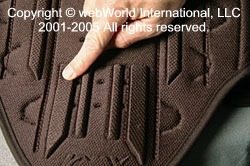
On the flip side, I also assumed that the back protector would add so much bulk that I’d have trouble fitting it under a motorcycle jacket.
The surprise here is that the Knox Ricochet fits very nicely under all of the jackets I tried.
We took two photos (below) of the back protector underneath an Olympia Vortech perforated leather jacket and the Tourmaster Advanced Cortech jacket. You can see that it’s not apparent that the model is wearing a back protector.
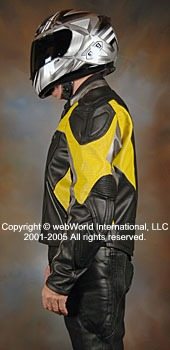
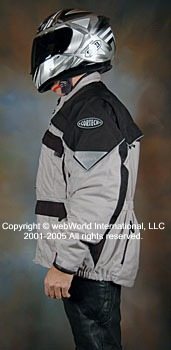
By the way, the Olympia jacket includes a decent little back protector that’s more substantial than the type that is provided in many other motorcycle jackets.
But you can see from the comparison photo below that it is pretty wimpy when compared to the Knox Ricochet.
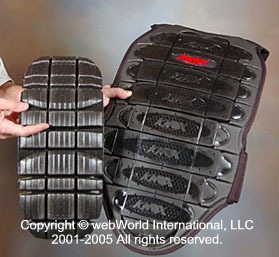
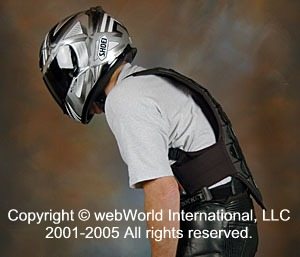
Conclusion
The Knox Ricochet takes some getting used to, and it’s probably not for every rider.
I’m always on the lookout for better protective equipment, and I’m in the process of exchanging the original equipment armor and padding in a couple of my outfits for the best race-type armor I can find.
Other than the “walking around with a board on your back” feeling, the Ricochet doesn’t really feel cumbersome, and it hides very nicely behind most jackets.
The fit and comfort is slightly dependent upon the owner’s height and the type of motorcycle; that is, it works better on a sport bike or sport-tourer with a slightly forward riding position, rather than a cruiser.
I am concerned about the stiffness of the lining. I’ll have to trust Knox on this one, but I don’t understand why the lining isn’t softer.
Wouldn’t a softer lining help cushion a blow to the rider’s back? We’ll plan on trying other brands of back protectors for a comparison.
More webBikeWorld:
| wBW Review: Knox Ricochet Back Protector | |
|---|---|
| Manufacturer: Knox Armor | List Price (2005): $159.00 (£59.99) |
| Colors: Black | Made In: Malaysia |
| Review Date: October 2005 | |
Where to Buy Knox Ricochet Back Protector
Also Shop for: Motorcycle Jackets, Motorcycle Gloves, Motorcycle Boots, Motorcycle Pants
Owner Comments and Feedback
See details on submitting comments.
From “J.H.”: “Nice piece on the “Ricochet” back protector. My only experience is with the “inverted cross” back protector in the Aerostich suit, not as heavy or stiff as this article but more than the jacket “armor” you showed for comparison.
You wondered about the lack of padding inside to make the fall comfy. I don’t mean that to sound sarcastic.
I spent more years of my life than probably makes sense to most people doing forms of martial arts like judo, jujutsu, and aikido in which there is a lot of time spent falling – or being forcibly hurled – for feet, rather than inches, of height of fall onto in most dojos padded floors.
However, though many American dojos now use foam padding of some sort, many still use stretched canvas over woven tatami mats, and some hard-core sorts like to train on beautiful but definitely firm wooden floors.
In order for students to survive the first months of training without bad injuries and realizing that it would be a lot better to do almost anything else than this form of self-destruction, it is pretty standard to find that students spend what they at first consider way too much wasted time and money practicing falling down.
That’s from a sitting position, from standing on their knees, from crouching over, from standing upright, and after they look like they’ve got that down from walking, running, and finally being tossed by someone else.
Once you get to the “tossed by someone else” stage, you figure out why Sensei made you spend so blasted much time toppling over. The point is to make it reflexive to make your landing with as much “flat” body surface as possible hitting the floor at once.
You have, say, a 150 pound body, dressed in a cotton training uniform, no pads, falling at a given speed.
If you’re into recalling physics, you can calculate the rate by how far you drop your center of mass multiplied by the acceleration constant of a free-falling body. Don’t bother.
If you drop 12 inches, it’s 150 foot-pounds plus a handful more for a short bit of acceleration.
Triple the distance – say, the height of being tossed over some cooperative opponent’s hip – it goes up enough to really get your attention if you hit wrong. Or even break parts.
What is “wrong”, or “right” about hitting the deck? Easy. Your basic “fall a few inches” test seems easy to you in the office, and pretty much is – especially with the pad, however hard.
Your 150 pounds is distributed over a goodly number of square inches of impact surface. If you have 75 square inches of body , and pad, surface hitting the floor at once, then the impact is 2 pounds per square inch.
Piece of cake, your Grandma can do it. But if instead you stick out your elbow to be the first point you land on, well, that’s one square inch taking the whole 150 pounds, which feels quite different.
Ratchet this up to someone who knows what they’re doing getting you up to the height of their shoulder and bringing you back down to the floor – you discover that Sensei is saving you a lot of cracked bones and damaged internal organs by teaching you how to spread out that impact.
So, why don’t people practice this wearing a thick layer of soft padding?
Besides that it makes you slow and clumsy and looks dorky, there’s the matter of whether it really helps much. Turns out it doesn’t, not as much as you’d think. It will of course decelerate your final inch of impact a bit, and that can’t be a bad thing.
But unless that is combined with the same “spread-out-the-impact idea, it doesn’t help enough to really prevent injury.
Come down at 300 foot-pounds or more on 7 instead of 70 square inches of body surface at once, and forget the padding you stuffed in your shirt, you’re going to do damage to whatever those few inches of impact point are.
Let’s hope it isn’t your skull, in which case your brain bounces around inside rather badly!
The point of this rambling story is that the “plywood board strapped to your back” in fact is the major part of the protection.
Presuming you have the luck, or the wit, to take your fall off the machine on your back (any votes for face first? I didn’t think so…) you will notice a large WHAM, probably have the breath slammed out of you, and fell bruised for a while.
But you will probably not wrench out of line, dislocate, create a major fracture, or otherwise break your spine, which is the point of the armor.
Adding a couple of pounds of padding and a couple of inches of added girth under your jacket or suit might save some on the bruising part.
But that’s small potatoes compared to the agony and paralysis the armor device is trying to prevent. Not a landing that feels good; but at a basic survival level, a landing you can walk – or at least hobble – away from.
I understand that thing is probably not very comfortable even if you “get used to it”.
That, and knowing that it is firm and hard, will probably discourage the great majority of riders from giving it any further thought.
In a way, that’s too bad. We’d have fewer people in wheelchairs if they all used one.
It’s just the other end of the scale from riding around in shorts and flip-flops.
Still, some of the idiots with no protection survive, and probably there will be a couple of people who die in their “Ricochet” because there’s only so much you can control once the ride disintegrates.
Enjoy your site and often browse it. Keep up the good work!”



No Comment